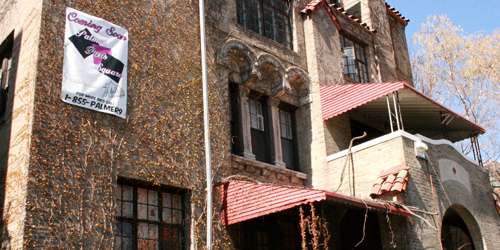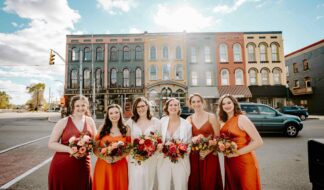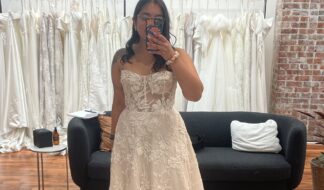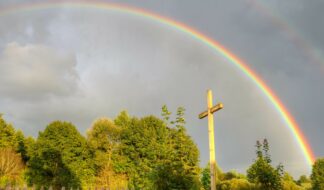
Renaissance. Resurgence. Revitalization. These are words bursting with hope and ambition and, in the past decade or two, have been bandied about in reference to just about every part of the city of Detroit you can imagine. Rarely, though, is their use justified and does the realization live up to the prediction.
But what's going on in Palmer Park just might be worthy of such a word. It's undeniable that something is happening there. A buzz is in the air. It might just be the early call of mosquitos emboldened by an astonishingly warm winter. More likely, though, it's the whispered prayers of residents past and present hoping to see their section of the city returned to the splendor for which it was once known.
Beginnings
Though most are at least vaguely aware that Palmer Park has long had a large gay population, few are aware of the area's beginnings and how the park became, well, the park. Sen. Thomas W. Palmer, a significant figure in Detroit history, inherited 80 acres from his grandfather and, in his lifetime, expanded his holdings to 640 acres. Basically, he owned the land between what is now Six Mile and Eight Mile Roads, between Woodward Avenue and Fairway Drive. It was Palmer's farm, his country home, where he raised prize Percheron and Arabian horses.
In 1894, Palmer donated 120 acres for a public park. The log cabin, which still sits in the park, was Palmer's. The pond, as we call it today, was actually built at Palmer's behest and named for his mother-in-law, Lake Frances. And one of the most stunning landmarks in the area, the Merrill Fountain, was donated to the city by Palmer's wife, in memory of her father. It was built in 1904 at a cost of $1 million and originally sat downtown in front of the Detroit Opera House before being moved to the park in 1923.
Palmer continued to donate land throughout his life, and following his death, and that of his wife, his benefactors subdivided what became known as the Palmer Park apartment district, which is actually now a part of the National Register of Historic Places.
"What's interesting is when you study the development of the park, from 1924, with the building of Palmer Lodge, to 1964, with the building of the Blair House, you had 40 years of a planned community," says Gregory Piazza, a Palmer Park historian and former resident of the area. "These architects were very aware of the light, the ventilation, how the buildings related to one another. So, architecturally, there's a rhythm to it."
There's a chicness and undeniable style to it as well. The buildings all have swanky names – LaVogue, the El Dorado, the Coronado, the Warwick, the Trocadero and the Madrid Court, just to name a few – and architectural flourishes – Art Deco brickwork, elaborate trims and articulated roof lines – in abundance. In short, it just screams gay. So when did happy homosexuals begin their pilgrimage to the area?
"It's a question people often ask me: When did it become gay?" says Piazza. "I think it's always been gay. When you look at old phonebooks, you see a lot of single men. I'm not saying they're all gay, but Palmer Park seemed to have more single men than the average per capita."
Piazza lived in Palmer Park from 1974 until 1991.
"That was really the height of its gayness," he says. "It's when it was really the mecca for gay people.
"For us as gay people, it's a major part of our history."
The area was chock-full of gay nightclubs and venues.
"You had the Glass House, Menjo's, Bookies, Tiffany's and the Back Stage near Six Mile," recalls Piazza. "Ted's Diner was not gay, but it was a great spot. Then closer to Seven Mile you had the Outlaw, Heaven, the Gas Station and the E Ramp. Chosen Books was between Menjo's and the Glass House. When I'm talking to younger gay men, the 45s and under, I try to (remind) them of what this neighborhood was."
Back to the future
The question, today, is what can this neighborhood become? Or, more specifically, can it be restored to its former glory? Piazza thinks it can. Though many of the buildings are boarded up, Piazza said they're not beyond hope.
"Normally, when you have a row of vacant buildings, in short order they're a mess," he says. "But that hasn't happened here."
Signs posted everywhere notify would-be vandals that the buildings are under armed guard. And there's another type of sign popping up all over the neighborhood. The signs read "coming soon" and "now renting."
The name behind a lot of these signs is Shelborne Development. The company just redeveloped LaVogue on Merton Road, a project that took 14 months.
"I lived in that building, so I know what it looked like," Piazza says. "They've done a fine, fine job. That's the other thing about redevelopment. Normally, when someone redoes a building, they just kind of do enough to get it rented. But that's not the case here."
No, Shelborne has a vision for Palmer Park, and, it seems, a great appreciation for its history.
"I think it has so much potential," says Shelborne's Kathy Makino. "The buildings themselves are just irreplaceable. They are just awesome buildings and we want to do whatever we can to bring those buildings and that area back."
In addition to LaVogue, Shelborne owns the Palmer Park Square complex, which includes 202 units in six separate buildings, and has control of six additional buildings.
"All together we have 13 buildings in the area," says Makino. "And if we do 13 buildings in that area, what an impact we can make."
But Shelborne Development isn't the only company expressing interest in Palmer Park.
"It's becoming kind of nationally recognized as a very unique area," Makino says. "Across the country, you just don't see this type of (apartment) neighborhood, so it has that potential to be redeveloped. I had a guy known for redeveloping historic neighborhoods call me from Vancouver. He called me specifically to come down and look at the area. He was just so impressed by it."
Impressed, also, is Piazza with Palmer Park's prospects. Thanks, in large part, to Makino and Shelborne Development.
"I'm so glad to see someone who has the sensitivity and the taste, who will bring a certain amount of that flair that this area used to have back to it," he says of the company. "It certainly had it when I lived here.
"My expectation is that it's going to find its rhythm again," he continues. "To me, a community has a certain pulse. It won't be the rhythm and pulse that I knew, but it will be indicative of the community that's here now."











